Are you scratching your head trying to figure out why black spots are appearing on the leaves of one of your favorite plants, like mint? This is a common problem for gardeners who are familiar with how subtle changes in environmental factors can affect the health of their herb gardens. In this blog post, we will cover the causes and solutions for managing black spots on mint leaves so that you can keep your plants looking healthy and vibrant! Read on to find out more about recognizing this issue, its potential causes, and what steps to take in order to fight back against it.
How Useful is Mint Herb?
Mint is an incredibly useful herb that has been used for centuries in a range of cultures around the world. Mint can be used to make refreshing teas, cooling drinks and flavorful dishes. It contains vitamins A, C, E and some of the B vitamins as well.

Mint is known for its calming effects on both the body and mind. The aromatic oils contained in the leaves are thought to help ease stress, anxiety and depression. Peppermint oil has also been found to help relieve nausea and headaches when inhaled or applied topically. [1]
In terms of skin care, mint contains anti-inflammatory properties which can help reduce redness or itchiness associated with skin conditions such as psoriasis or eczema. Its cooling effect can help soothe and refresh skin, as well as relieve muscle aches or tiredness.
Mint is a versatile herb that is easy to grow in most climates and can be used fresh or dried in various recipes. It makes for a refreshing addition to both sweet and savory dishes. Mint is also a popular ingredient in many health and beauty products, from facial scrubs to toothpastes. From soothing tea to skin cleansers, mint has something for everyone!
So if you’re looking for a refreshing herb with multiple uses, look no further than mint! Its unique flavor and beneficial properties make it an incredibly useful natural remedy that can help you stay healthy and look good. Try incorporating mint into your recipes today for a delicious taste of nature’s goodness. [2]
How to Grow Mint?
Mint is a popular herb that can be grown indoors or outdoors. For an indoor garden, mint should be planted in containers with good drainage to prevent root rot and overwatering. Use a rich soil mix such as organic potting soil and add some perlite for additional drainage. Place the container near a sunny window or use supplemental lighting if necessary. Water the plant when the top inch of soil feels dry and keep it consistently moist, but never soggy. Pinch off any dead leaves to encourage new growth and fertilize every two weeks using a water-soluble fertilizer formulated for herbs.
Outdoors, mint prefers full sun but will tolerate partial shade. Plant in rich, well-drained soil and keep it consistently moist. Pinch off any dead leaves and fertilize every two weeks with a water-soluble fertilizer formulated for herbs. Harvest the leaves often to encourage new growth and be sure to contain the plant if you don’t want it taking over your garden. With proper care, mint will provide you with flavorful leaves throughout the growing season! [3]
Is Mint Picky in Cultivation and Care?
No, mint is not particularly picky in cultivation and care. It can be grown either from seed or cuttings and it can thrive in any soil condition. Although they prefer moist, well-draining soil, they will tolerate slightly dry conditions. The most important thing to remember when caring for mint is that it tends to spread quickly so you should contain it by planting it in a pot or container with drainage holes.
Mint generally prefers full sun but will also do well in partial shade. It should be watered regularly and fertilized every few months if growing indoors. Pruning the plant back after blooming will encourage further growth and flowering throughout the season. Furthermore, mint does require some protection from extreme temperatures, so be sure to cover it with a sheet or tarp during cold winters. Overall, mint is an easy-to-care-for herb that can bring you lots of delicious culinary and medicinal benefits. [4]
What Diseases Can Mint Suffer From?
Mint can suffer from a variety of diseases, some of the most common being powdery mildew, verticillium wilt, root rot, and aphid infestations.
- Powdery mildew is a fungal disease that affects the leaves and stems of mint plants, causing them to become covered in white or gray powdery spots.
- Verticillium wilt is caused by soil-borne fungi that attack the plant’s vascular system, leading to wilting and yellowing of the leaves.
- Root rot is a fungal infection that attacks the roots of mint plants and can lead to stunted growth or even death.
- Aphids are small insects that feed on plant sap and can cause damage to mint leaves or stems if left untreated. [5]
Proper cultural practices are essential to prevent these diseases from affecting your mint plants. Regularly removing dead or diseased leaves and stems, as well as keeping the soil moist but not overly wet will help protect your plants from disease.
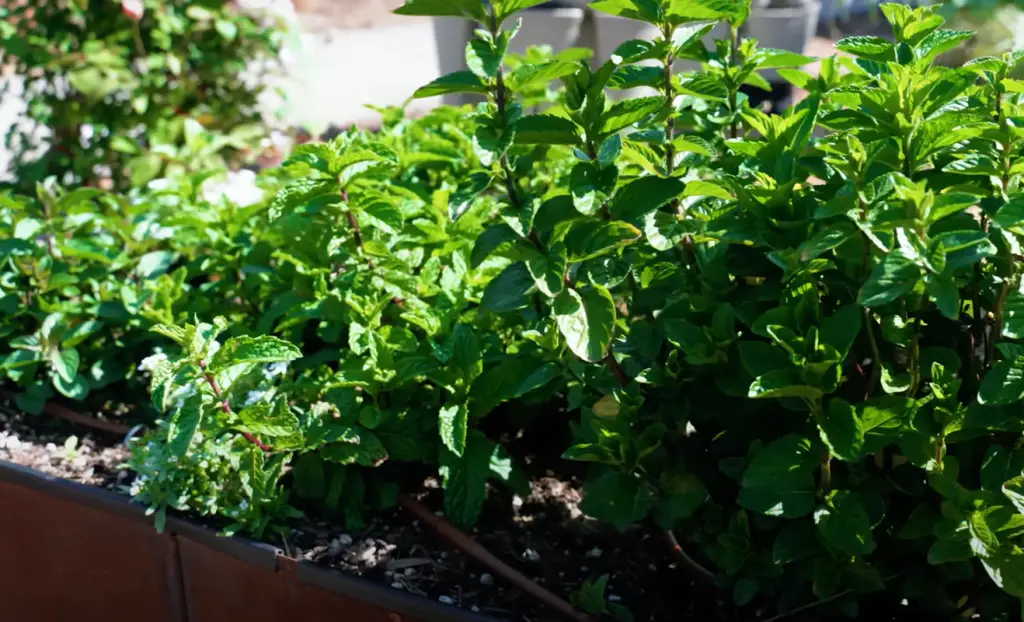
Additionally, using mulch around the base of mint plants can help protect their roots from rot and keep them healthy. If any of these diseases do occur, you may need to use a fungicide or insecticide in order to fully eradicate them.
It is also vital to practice good sanitation when growing mint in order to prevent spreading disease from one plant to another. You should avoid watering your mint with overhead irrigation methods or sharing tools between different plants in order to minimize spread of disease. Planting mint varieties that are resistant to certain diseases can also help keep your plants healthy. [6]
Overall, good cultural practices and regular inspections of your plants will go a long way in keeping them healthy and disease-free. With the right care, you can enjoy a lush garden of mint for many years to come.
How to Fight Mint Diseases?
Mint diseases can cause a great deal of damage to the plants. In order to reduce the amount of damage from these illnesses, there are a few things that can be done. These include:
- Plant resistant varieties of mint. Many different types of mint possess natural resistance or tolerance to certain diseases. Be sure to check with your local nursery or garden center for information about which varieties may work best in your region.
- Practice good gardening habits, such as removing any dead leaves and debris, spacing plants adequately, and not overwatering them. This will help to reduce the number of pests and microbes that could easily spread disease amongst the plants.
- Provide adequate drainage for your mint plants. Excessively wet soil can cause the spread of disease and lead to root rot, a common issue with mint.
- Practice crop rotation for your garden’s health. Don’t plant different varieties of mint in the same spot from year to year or in close proximity in general; this will reduce the amount of fungal spores and other disease-causing organisms that can build up on these plants over time.
- Prune your plants regularly in order to get rid of any weak stems or diseased leaves that could be harboring pathogens, as well as to keep them looking their best.
- If necessary, you may also use fungicides and other chemicals to help control and prevent the spread of mint diseases. Be sure to follow all instructions and safety precautions when applying these products.
Key Reasons Of What Causes Black Spots on Mint Leaves?
Mint plants are susceptible to a number of fungal and bacterial diseases which cause black spots on the leaves. The most common causes of black spots on mint leaves include:
Fungal Leaf Spot
A number of fungi can attack mint plants, causing small, dark spots with yellow halos on the leaves. These spots may enlarge over time, eventually killing the entire leaf. Fungal leaf spot is generally caused by wet weather conditions or high humidity levels in the garden. It can also be spread from infected plants to healthy ones via splashing soil or water droplets.
Bacterial Leaf Blight
Bacterial leaf blight is another common disease that causes black spots on mint leaves. These spots are usually small, round, and dark in color. They may also have a yellow halo around them. The disease is spread through water droplets that contain the bacteria, and can cause damage to the entire plant if left untreated.
Powdery Mildew
Powdery mildew is another fungal disease which causes black spots on mint leaves. It appears as white powdery patches on the topside of the leaves, with small black dots underneath. This disease is more common in warmer climates, but can still occur in cooler areas as well.
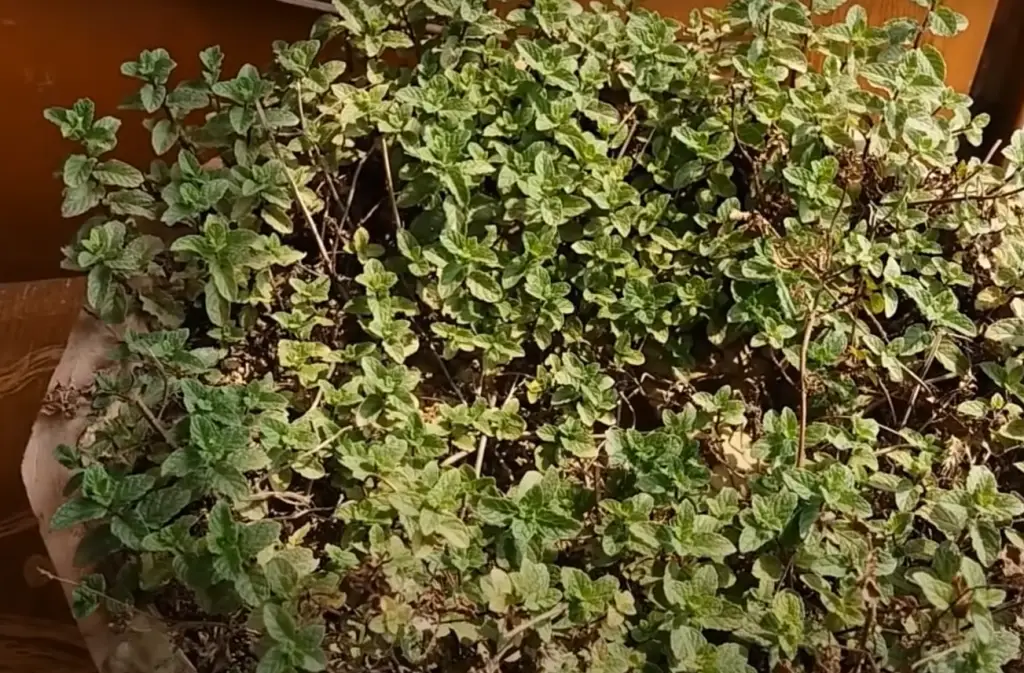
High humidity levels or poor air circulation in garden areas makes plants more susceptible to this type of fungus.
Environmental Stress
In some cases, environmental stress can cause black spots on mint leaves. This could be due to extreme temperatures, water fluctuations or lack of nutrients in the soil. If environmental stress is detected, it’s important to address the issue quickly in order to prevent any further damage or disease from occurring. [7]
By identifying and addressing the underlying causes of black spots on mint leaves, gardeners can help to keep their plants healthy and looking great! Unsightly leaf spots indicate that something isn’t right with a plant’s environment or health so try to diagnose and treat the issue promptly for best results.
Is It OK to Fertilize Mint?
It is ok to fertilize mint, as long as the fertilizer is natural and organic. Fertilizing mint helps bring important nutrients into the soil that will help promote healthy growth of the plant. Although mint plants do not need a large amount of fertilizer, they should be fertilized once in early spring and again in mid-summer for best results.
In general, it’s best to stick with natural and organic fertilizers when feeding your mint plants. Finally, always remember to water your plants deeply after fertilizing them – this will help the fertilizer penetrate into the soil and provide the best nutrients for your plants.By following these guidelines, you can ensure that your mint plants stay healthy and vigorous throughout the growing season. [8]
Is It Possible to Plant Mint Near Other Herbs?
In fact it is possible to plant mint near other herbs. It is known for its ability to spread quickly and easily so it can be planted close to other herbs without worry of crowding out the others. It’s best to give each herb its own small plot of soil if planting in a garden bed, and consider containing the mint with a barrier like a plastic pot or low stone wall if necessary.
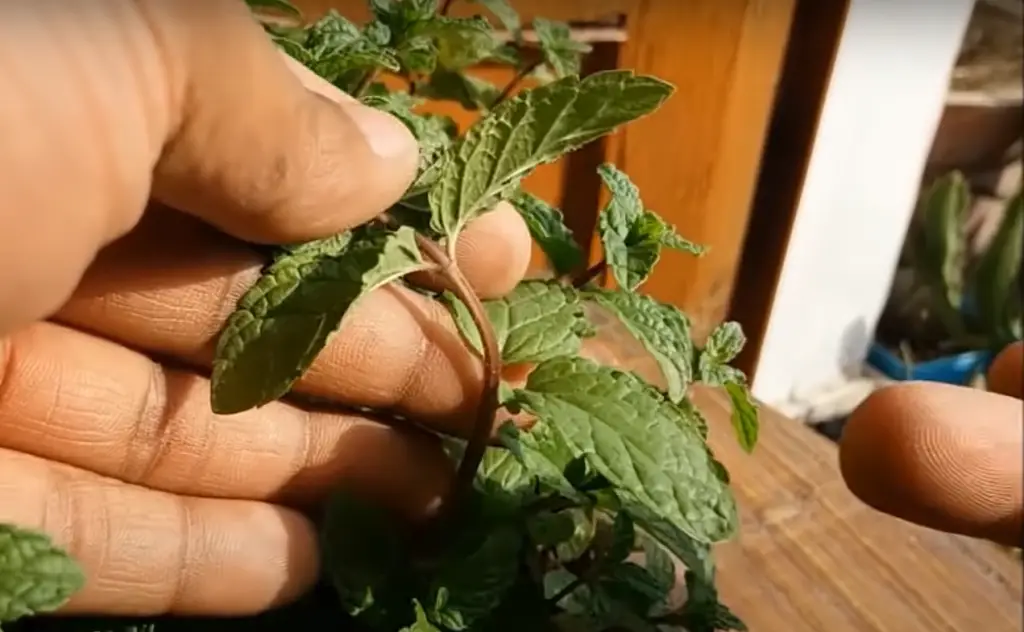
That way, the mint won’t take over more space than desired while still allowing for companion planting benefits. Planting mint near other herbs can help improve the flavor of those plants and provide additional pest control due to its strong scent and taste. Herbs such as basil, oregano, rosemary, thyme, sage, and chives are all great companions to plant near mint for these benefits.
Additionally, other pest repellent plants like garlic, lavender, marigolds, and onions can be planted close to mint as well. If planting in containers, remember that mint thrives in moist soil and should be watered more frequently than other herbs. With regular watering and maintenance of the area, it is possible to safely plant mint near a variety of herbs with lasting success. [9]
FAQs
How often do you water mint?
Mint should be watered regularly, usually every 7-10 days when temperatures are above 70°F (21°C). During hotter months, you may need to water more often as the soil can dry out quickly. It is important to always check the soil moisture before watering, as overwatering can cause root rot and other problems. Additionally, mint benefits from fertilizer during the growing season for best growth. A balanced fertilizer applied once a month should suffice.
How do you treat leaf spots naturally?
There are several ways to treat leaf spots naturally. One way is by using a mixture of baking soda and water to create a paste that can be applied directly to the affected area. This paste helps neutralize the pH levels in the soil, making it more difficult for fungi and bacteria to survive. You can also use neem oil or garlic spray as natural fungicides. This will help protect your plants from any further infection by killing off existing fungal spores. You should apply these treatments at least once a week until there is no visible sign of disease remaining on your plants’ leaves.
Another effective treatment for leaf spot is using compost tea or other organic liquids containing beneficial bacteria. These organisms work to fight off the disease-causing pathogens and help restore the natural balance in your garden. Finally, you can also encourage beneficial insects like ladybugs to come to your garden as they eat many of the common fungal and bacterial diseases that cause leaf spots.
How do you treat black spots on mint?
The first step is to identify the source of the problem. Once you have identified the issue, there are a few different methods you can use to get rid of black spots on your mint plants. The most common cause of these spots is a fungal infection, usually due to too much moisture. If this is the case, you should reduce watering and improve air circulation around your plant by pruning any overcrowded or damaged stems. Additionally, it’s important to remove any affected leaves or stems as soon as possible since this will help prevent further spread of the fungus.
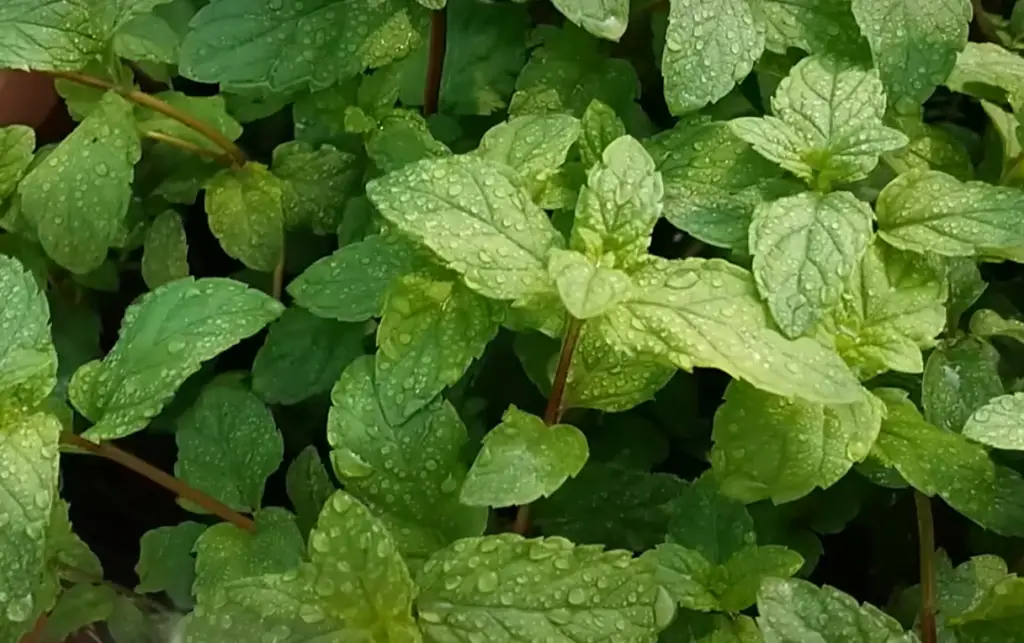
If you suspect that an insect infestation might be causing black spots on your mint plants, then inspect the leaves for signs of damage like holes or discoloration. Treating the infestation with a pest control product is the best course of action if this is the case.
What causes black spots on mint?
Black spots on mint are typically caused by a fungus known as Cercospora. This fungus affects the leaves of the plant, causing them to turn yellow and develop brown or black spots. The spots may become larger over time, eventually resulting in wilting and leaf death.
Useful Video: HOW TO MAKE YOUR MINT HEALTHY AGAIN -FAST N EASY
Conclusion
Mint is a great addition to any garden or home, but with its delicate nature, there is the risk of potential disease. Although these conditions can be addressed by taking the right precautions, there are plenty of other steps to get more value out of your mint plants. These may include rotating crops each year to avoid insect and nutrient buildup, keeping weeds and debris away from your plants, and addressing black spots on the leaves as soon as they appear. All of these steps can help you get the most out of your mint plants and keep them thriving for years to come. Plus, we hope that our advice has given you the knowledge and confidence to take control of your mint’s health and maintain it with ease.
References:
- https://www.healthline.com/nutrition/mint-benefits
- https://pharmeasy.in/blog/benefits-of-mint-leaves/
- https://www.gardenersworld.com/how-to/grow-plants/how-to-grow-mint/
- https://morningchores.com/growing-mint/
- https://gardeningtips.in/18-common-mint-plant-problems-how-to-fix-them-solutions-and-treatment
- https://plantvillage.psu.edu/topics/mint/infos
- https://gardenforindoor.com/black-spots-on-mint-leaves/
- https://homespursuit.com/how-when-fertilize-mint-plant/
- https://blog.gardenuity.com/herbs-to-plant-together/





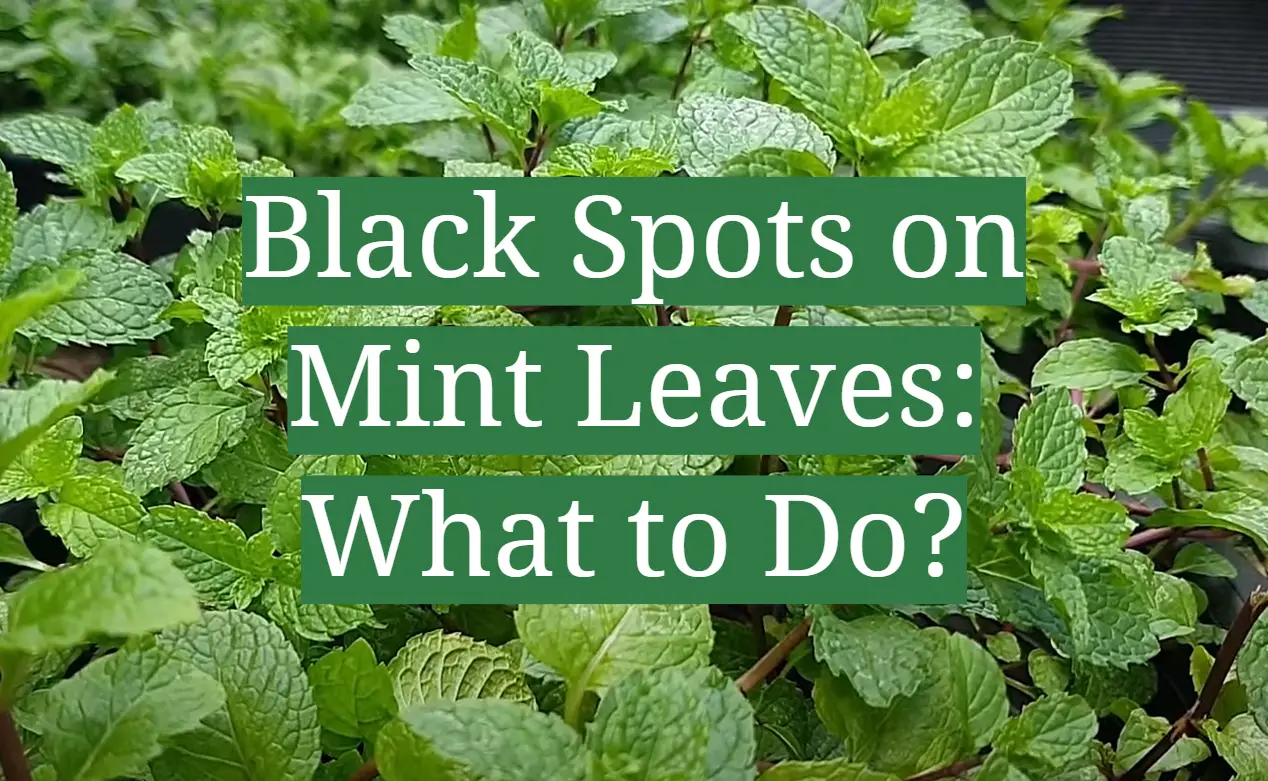

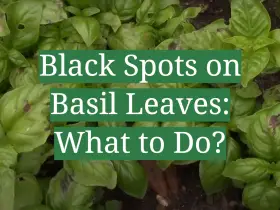


Leave a Reply
View Comments